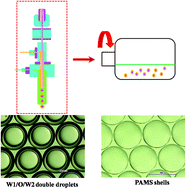Our official English website, www.x-mol.net, welcomes your
feedback! (Note: you will need to create a separate account there.)
Influence of fluorobenzene mass transfer on the qualities of poly-α-methylstyrene shells
RSC Advances ( IF 3.9 ) Pub Date : 2018-01-19 00:00:00 , DOI: 10.1039/c7ra09799a Chen Qiang 1, 2 , Chen Sufen 2 , Liu Meifang 2 , Pan Dawei 2 , Li Bo 2 , Zhang Zhanwen 2 , Qi Xiaobo 2
RSC Advances ( IF 3.9 ) Pub Date : 2018-01-19 00:00:00 , DOI: 10.1039/c7ra09799a Chen Qiang 1, 2 , Chen Sufen 2 , Liu Meifang 2 , Pan Dawei 2 , Li Bo 2 , Zhang Zhanwen 2 , Qi Xiaobo 2
Affiliation

|
Polymer shells prepared by the microencapsulation technique with perfect sphericity and defect-free surface finish are demanded in inertial confinement fusion (ICF) experiments. The sphericity and surface finish are some of the hardest specifications to fulfill. Driven by the need to improve qualities of the polymer shells to meet the critical specifications, the effects of fluorobenzene (FB) mass transfer rate on sphericity and surface finish were investigated and the mechanisms of the effects of FB mass transfer on sphericity and surface finish of poly-α-methylstyrene (PAMS) were also discussed. The sphericity and surface finish of the PAMS shells are greatly improved by decreasing the FB mass transfer rate. The calculative frequency of the final shells with an out-of-round (δOOR) of less than 2 μm increases from 30% to 80%, while the power spectra density (PSD) plot gets closer to the specification of the national ignition facility (NIF). The tracking experiments show that the curing process is extended and the percolation transition is also postponed by decreasing the FB mass transfer rate. Therefore, the interfacial tension can work sufficiently, helping make double droplets become spherical, since the double droplets’ stay in the liquid state is effectively extended. Moreover, the Marangoni instabilities at the O–W2 boundary are also restrained by controlling the mass transfer, due to the diffusivity of FB being slowed down. Both the results and methods presented in this work provide a more in-depth understanding of the curing process and the mass transfer, to the benefit of fabricating polymer shells with high sphericity and defect-free surface finish used in ICF experiments.
中文翻译:

氟苯传质对聚α-甲基苯乙烯壳质量的影响
惯性约束聚变 (ICF) 实验需要通过微胶囊技术制备的具有完美球形度和无缺陷表面光洁度的聚合物壳。球形度和表面光洁度是一些最难满足的规格。由于需要提高聚合物壳的质量以满足关键规格,研究了氟苯 (FB) 传质速率对球形度和表面光洁度的影响,以及 FB 传质对球形度和表面光洁度的影响机制。还讨论了聚-α-甲基苯乙烯(PAMS)。通过降低 FB 传质速率,PAMS 壳的球形度和表面光洁度大大提高。最终壳的计算频率与不圆 ( δ OOR) 小于 2 μm 从 30% 增加到 80%,而功率谱密度 (PSD) 图更接近国家点火设施 (NIF) 的规范。跟踪实验表明,通过降低 FB 传质速率,固化过程得到延长,渗流转变也被推迟。因此,界面张力可以充分发挥作用,有助于使双液滴变成球形,因为双液滴在液态的停留时间得到了有效延长。此外,由于 FB 的扩散速度减慢,O-W2 边界处的 Marangoni 不稳定性也通过控制传质得到抑制。这项工作中提出的结果和方法都提供了对固化过程和传质的更深入的理解,
更新日期:2018-01-19
中文翻译:

氟苯传质对聚α-甲基苯乙烯壳质量的影响
惯性约束聚变 (ICF) 实验需要通过微胶囊技术制备的具有完美球形度和无缺陷表面光洁度的聚合物壳。球形度和表面光洁度是一些最难满足的规格。由于需要提高聚合物壳的质量以满足关键规格,研究了氟苯 (FB) 传质速率对球形度和表面光洁度的影响,以及 FB 传质对球形度和表面光洁度的影响机制。还讨论了聚-α-甲基苯乙烯(PAMS)。通过降低 FB 传质速率,PAMS 壳的球形度和表面光洁度大大提高。最终壳的计算频率与不圆 ( δ OOR) 小于 2 μm 从 30% 增加到 80%,而功率谱密度 (PSD) 图更接近国家点火设施 (NIF) 的规范。跟踪实验表明,通过降低 FB 传质速率,固化过程得到延长,渗流转变也被推迟。因此,界面张力可以充分发挥作用,有助于使双液滴变成球形,因为双液滴在液态的停留时间得到了有效延长。此外,由于 FB 的扩散速度减慢,O-W2 边界处的 Marangoni 不稳定性也通过控制传质得到抑制。这项工作中提出的结果和方法都提供了对固化过程和传质的更深入的理解,











































 京公网安备 11010802027423号
京公网安备 11010802027423号